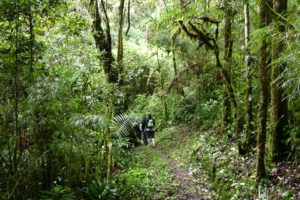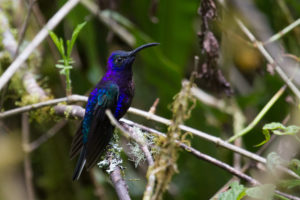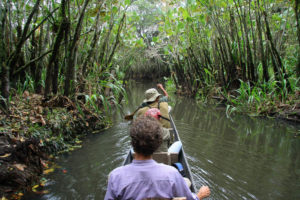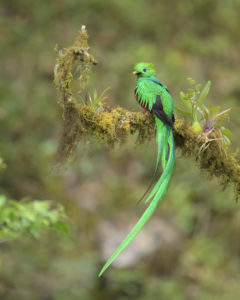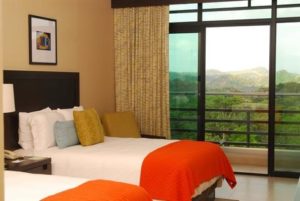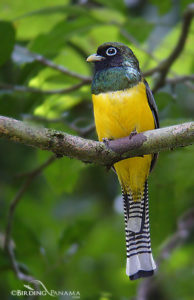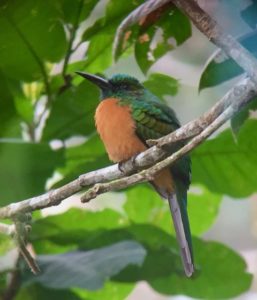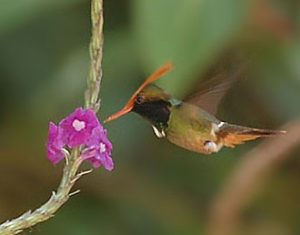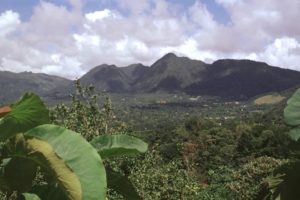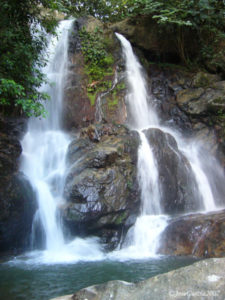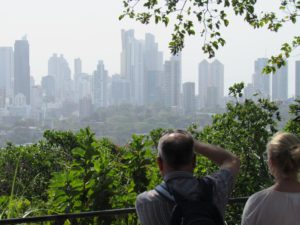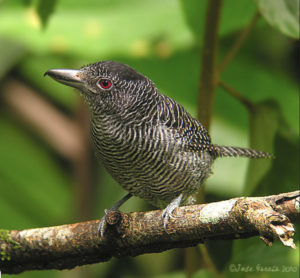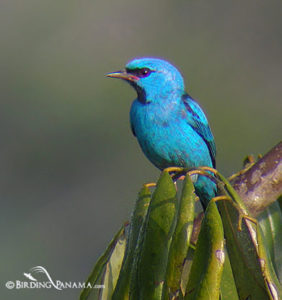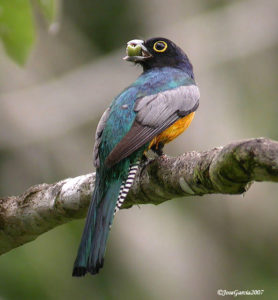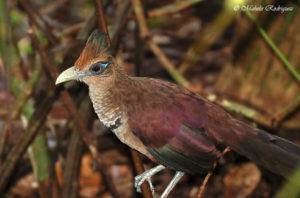Birding Panama
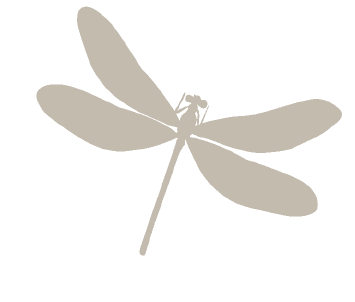
January 10 to January 19 2020
$3,250 | ($500 deposit due upon registration)
12 participants max
Discover technicolor butterflies and astonishingly camouflaged praying mantids underneath forests full of Blue-throated Toucanets and Fiery-billed Aracari. Gaze out your bedroom window at Spider Monkeys and Scarlet Macaws moving through the rainforest canopy. Trek into the volcanic high-country in search of the sacred and stunning Resplendant Quetzal. Watch dazzling hummingbirds sip nectar from inumerable tropical flowers while the roars of Howler Monkeys echo in the distance. Few places on earth offer such biodiversity. Take a left off the Pan-American Highway and drive straight into the heart of the jungle.
Additional Information
Flow of the Day: The itinerary is designed to maximize our experience with the great diversity of birdlife and ecosystems that Panama offers. We won’t, however, be rushing from place to place to chase the largest species list possible. Our goal is to spend time appreciating the species we encounter at an enjoyable pace. Birding walks begin in the early morning, and we travel slowly to allow for the best bird and wildlife encounters and observation.
We visit several private reserves, gardens, and feeders where it is easier to find many of our target species. The driving and the flights are scheduled during hot hours when the activity is slower. Afternoon plans typically allow for some afternoon rest time at the lodges, though this is not always feasible when we are transferring between lodges and landscapes.
Climate: The annual average temperature on the Canal Area is 84°F, and it ranges from 50 to 66°F at various mountain elevations in the Chiriquí Highlands. The period of lightest rainfall is from mid-December to mid-April.
Clothing: Pack light field clothing of neutral colors. Bring several pairs of long pants and comfortable, light, airy shirts. Long-sleeved (relaxed fit) shirts are useful for protection from the sun, as is a light hat or cap. Good rain gear is essential, and a small umbrella is also recommended. Be sure to have a pair of comfortable walking shoes or hiking boots, plus a second pair of tennis shoes or sandals. A sweater or fleece is important for the Chiriquí Highlands. You may want more casual clothing for traveling or dinners. A small washcloth and handkerchiefs will be helpful.
Equipment: Bring a pair of binoculars, a field guide and a camera with extra batteries. The guides will have two spotting scopes. Pack sunglasses and sunscreen, a small flashlight or headlamp, a small alarm clock (a smartphone will work), insect repellent, a small daypack, and a small folding stool if you get tired standing for long periods waiting for birds.
Health Considerations: Please consult your physician before the trip for any recommended immunizations. Mosquitoes and other small, biting insects can sometimes be a nuisance in Panama, especially in the forested areas. Chiggers are found in most of the grassy areas. We suggest a stick-type repellent for your face and hands, plus at least one pump-style container of repellent for your clothing. As for foods, all salads, dairy products and meals at the different lodges are perfectly safe to eat. Bottled water is provided while on tours.
Participants should be able to hike on moderate terrain up to 2 miles per day, and be ready to expect conditions that may be hot, cold, dry, wet, or anything in-between.
Transportation: The land transportation is in registered minibuses with A/C, a necessary luxury in the humid lowlands of Panama. The sky transportation to the Chiriquí Highlands uses a F70 Fokker twin-engine jet airliner airplane with a 70-80 passenger capacity.
Weight restrictions: For our domestic Chiriquí Flights, a maximum of 30 lbs. of checked luggage and 10 lbs. of carry-on per person is allowed. Arrangements can be made to safely store extra luggage at the Radisson Summit Golf Hotel, where we will return to for the final night of our journey.
Peace of Mind: Panama is a place of kind hearts, modern infrastructure, and spectacular biodiversity. It is among the safest, easiest, and most comfortable places to travel in Central/South America. Travelers concerned about visiting unknown destinations where English is not the primary language will find that Panama is the perfect gateway to tropical nature travel.
Our in-country bird guide, Euclides Campos, a regionally renowned bilingual bird expert with a deep knowledge of bird vocalizations and identification skills. Euclides is adept at finding many sought-after species, helping guests sight birds in challenging rainforest cover, and educating participants in the ecology and identification of each species. Euclides has a deep knowledge of natural and cultural history, and a degree in Nature Tourism. Born and raised in Panama, Euclides has a whopping in-country bird list of 768 species and has participated in several international avian research programs.
Our NBNC guide is Staff Naturalist, Sean Beckett. Sean guided wildlife safaris and birding trips across North America for the last decade. His background includes several avian research positions ranging from Atlantic Puffin monitoring in coastal Maine to Ferruginous Pygmy-owl sampling in northern Mexico. Sean holds a M.S. from the Unversity of Vermont's Field Naturalist program. Sean has birded the Panamanian rainforests on two occasions, and organized this trip to share his favorite experiences with fellow travelers.
Both guides carry Swarovski spotting scopes and a plethora of birding books and resources.
Radisson Summit Golf Hotel – first 2 nights and final night: Located in the Old Canal Zone, this comfortable lodge is outside Panama City, at the edge of the rainforest, and less than 15 minutes from some of the best birding destinations in Central America. Amenities include private rooms with standard electrical plugs, full baths, hot water, wifi, laundry service, bar, restaurant, and nature trails.
Canopy Tower – 1 night: The Canopy Tower is a prime location from which to observe the birds and other wildlife of the forest canopy. Located in Soberania National Park. Amenities include wifi, dinners with wine, full baths, hot water, and private rooms.
Anton Valley – 2 nights: Located in El Valle, a foothill town within a volcanic crater, this lodge includes a full restaurant, wifi, bar, private rooms with electricity plugs, full baths, and hot water.
Hotel Dos Rios (Western Highlands) – 3 nights: This nice hotel is located at Volcán at an elevation of 1500m. Amenities: Private rooms with electricity, full baths, hot water, laundry service, bar, restaurant, nature garden with plentiful birdlife.
The trip cost includes:
- Pre-departure orientation gathering at NBNC
- Expert NBNC guide
- In-country expert bird guide
- Airport hotel transfers
- All accommodations
- Entrance fees to parks
- Domestic flights between Panama City and David
- All transportation in a private bus
- Water
- Luggage storage arrangements
- All meals during the trip
The trip cost does not include:
- Airfare to and from Panama
- Cancellation insurance
- Alcoholic beverages
- Extra hotel services
- Snacks
- Meal gratuities
- Guide gratuities
Ready to go to Panama?
Email [email protected] to get signed up.
For a list of species seen on a comparable itinerary by our in-country partners, Click Here
Itinerary
Day 1 – Jan 10: Arrival to the Rainforest
We are met at the airport in Panama City by our guide and driver and whisked away to the Radisson Summit Golf hotel, our lodge in the rainforest just 45 minutes away. The hotel is located atop a hill on the Cruces Trail National Park (Canal Zone), and contiguous with the Soberania National Park. Overnight: Radisson Summit Golf Hotel.
Day 2 –Jan 11: Pipeline Road
We spend the day birding the famous Pipeline Road and the surrounding areas of the Soberania National Park. We’ll walk the famous Pipeline Road looking for Great Jacamar, Black-tailed Trogon, Pheasant Cuckoo and many other forest birds. Some of the easier-to-photograph birds may include: Slaty-tailed Trogon, Black-breasted Puffbird and Broad-billed Motmot. We’ll then visit the ammunition dumps near Gamboa to look for the Rufescent Tiger-Heron and the White-throated Crake. Overnight: Radisson Summit Golf Hotel.
Day 3 – Jan 12: Metropolitan Nature Park & Canopy Tower
With a list of 267 species, the Metropolitan Nature Park is the largest tropical forest park within the limits of a Latin American city. This a great place to find birds of the Pacific forest of the Panama Canal. Some of the key birds are Yellow-green Tyrannulet (a rare national endemic), Lance-tailed Manakin, and the elusive Rosy-thrush Tanager. After lunch in a local restaurant, we will settle in at the nearby Canopy Tower, a famous birding lodge with bedrooms right at treetop-level. The afternoon may be spent birding the property, or enjoying treetop specialists from right out the windows. The Canopy Tower also features fruit feeders that attract a wide range of tanagers and other species. Check out their live camera of the feeders! Overnight: Canopy Tower.
Day 4 –Jan 13: Old Gamboa Road & Plantation Road - Drive to El Valle
Today we explore another hotspot on the Canal corridor and nearby Summit Ponds looking for Spectacled Owls, Blue-crowned Motmots, Amazon, Green, and Ringed Kingfishers and nesting Boat-billed Herons. We’ll then visit the evergreen forest of Plantation Road, where we may find army ant swarms and the specialist birds that follow these swarms like Spotted Antbird and Ocellated Antbird. Some other specialties of the Plantation Road include: Golden-crowned Spadebill, Olivaceous Flatbill, White-whiskered Puffbird, and more. The rainforest of the Panama Canal is highly diverse, and we’ll review our growing species list at the end of each day! After lunch at the Canopy Tower, we’ll travel 1 ½ hours west to El Valle. Overnight: Anton Valley Hotel.
Day 5 – Jan 14: EL Valle Foothills
This morning, we explore the Cerro Gaital and La Mesa area. This area is at higher elevation than the town itself. Much different than the lowland canal zone, today’s habitat features wet foothill forests. We’ll spend the day searching for species typical of these environments, such as Tody Motmot, Spectacled Owl, Spot-crowned Barbet, Flame-rumped Tanager, Yellow-eared Toucanet and more. Overnight: Anton Valley Hotel.
Day 6 – Jan 15: EL Valle Foothills & Flight to David
We will bird the town of El Valle this morning, a picturesque town located in the crater of an extinct volcano. The town has year-round spring weather thanks to its 700-meter elevation. Here we may add Silvery-throated Tanager, Orange Bellied Trogon, and Blue-throated Toucanet to our list. After lunch, we drive back into Panama City for a 45-minute flight westward to David. Upon arrival, we will be greeted by our excellent driver to be taken to the famous town of Volcan, where we will stay 3 nights to find highland birds and many endemics. Night: Hotel Dos Rios.
Day 7 – Jan 16: Los Quetzales Trail & Volcán Baru National Park
Today is focused on finding Resplendent Quetzals with our specialist guide. This bird forages primarily on wild avocados, and this region is flush with these trees. The Quetzal was a sacred symbol of the Aztecs and Mayas, and the bird itself represents liberty in today’s cultures. Its name is an ancient Indian term for tail feather. We will also be keeping an eye out for Long-tailed Silky-Flycatcher, Barred Becard, Black-faced Solitaire, Chestnut-capped Brush-Finch, Black-capped Flycatcher, Buffy Tuftedcheek, Ruddy Treerunner Blue-throated (Emerald) Toucanet and more. We’ll continue birding around the Cerro Punta region looking for more highland birds and endemics. Overnight: Hotel Dos Rios.
Day 8-Jan 17: La Amistad International Park
Also known as Parque Internacional la Amistad, this park is a World Heritage Site and part of the Talamanca Mountains. This volcanic rage contains the highest concentration of endemic and threatened species in Panama, such as Silvery-fronted Tapaculo, Yellow-thighed Finch, Collared Redstart, Flame-throated Warbler, Prong-billed Barbet and Wrenthrush (Zeledonia). We will also visit Birding Paradise (Reserve), a hot spot where there are many hummingbird feeders and fruit tables that attract significant numbers of species for easy observation and photography. Overnight: Hotel Dos Rios.
Day 9 – Jan 18: Volcan Lakes & Chiriquí Highlands
The lakes near Volcán are very good places to find species not found on the higher slopes of Cerro Punta. Wetland species may include Masked Duck and Northern Jacanas. Interesting birds of the nearby woodland areas may include wintering Golden-winged Warblers, Olivaceous Piculet, Spotted Woodquail, Pale-breasted Spinetail, Fiery-billed Aracari and Collared Trogon. After lunch, the group will head back to David to take a late afternoon flight to Panama City. Overnight: Radisson Summit Golf Hotel.
Day 10 –Jan 19: Departure to Tocumen Airport
After some early morning birding around the property and a hearty farewell breakfast, we’ll transfer from the hotel back to the Tocumen Airport in Panama City for our departure flights back home.
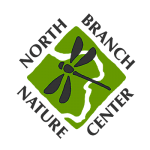
713 Elm Street
Montpelier, Vermont 05602
(802) 229-6206
Hours: Center Open Monday-Friday 9-4
Trails Open 24/7

